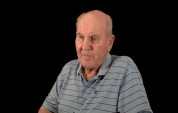2:20 | The Ploesti oil fields were dangerous for American airmen. Many German fighters and much flak. The first time B-24 gunner Art Morin flew there, his aircraft was the only one from his formation to return. (This interview made possible with the support of STANLEY T. KOCZUR.)
Keywords : Art Morin gunner Ploiesti Romania oil fields German fighter anti-aircraft (AA) flak formation flying Consolidated B-24 Liberator

He enlisted for pilot training, but Art Morin had to settle for tail gunner. On his way to Italy, he had a minor medical problem which forced him to wait in Puerto Rico for a month. Tough duty. (This interview made possible with the support of STANLEY T. KOCZUR.)
He never flew with the pilot he accompanied to Italy, but B-24 gunner Art Morin was in the air right away, flying missions deep into Germany. The P-38 escorts were no match for the German Me-109's, and the flak was intense. (This interview made possible with the support of STANLEY T. KOCZUR.)
It was basically a suicide mission. B-24 gunner Art Morin remembers that they were told at the briefing that half the aircraft would probably run out of gas. He was on the runway waiting to take off when he got word that the odds had turned around. (This interview made possible with the support of STANLEY T. KOCZUR.)
Fragmentation bombs posed special problems for the B-24 crews, recalls Art Morin. They were small, quickly armed and banded together in clusters. On one mission, the band broke. (This interview made possible with the support of STANLEY T. KOCZUR.)
Was it cold on those bombing missions? Oh yes, says B-24 gunner Art Morin. It could be 50 degrees below zero and if any part of your electrically warmed clothing malfunctioned, you were vulnerable to frostbite. (This interview made possible with the support of STANLEY T. KOCZUR.)